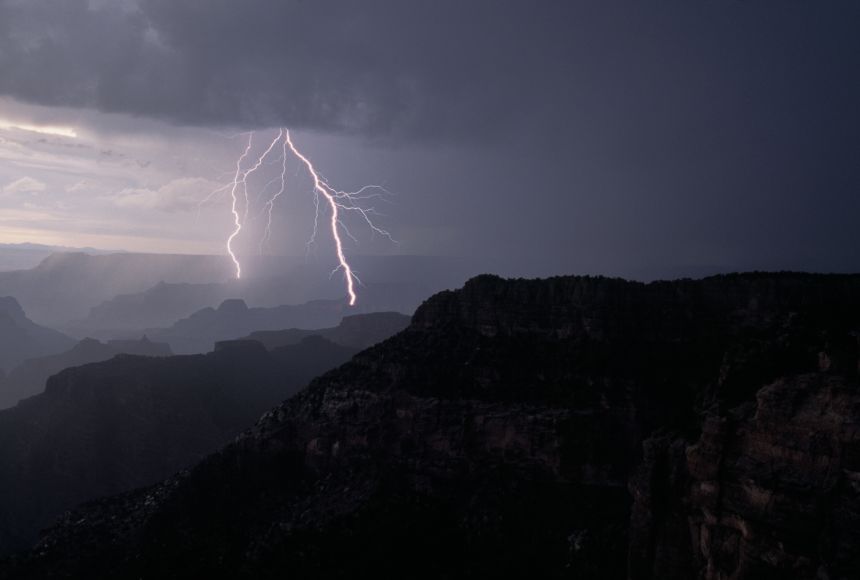Nearly all scientists agree that climate change is real, and that it is caused by human activity. At the same time, however, we have had some record-breaking cold winters. In January 2019, a polar vortex plunged parts of North America into Arctic conditions. In the weather event, the cold air and low pressure that normally surrounds the north pole moved south, causing bitter cold conditions.
Yet cold weather does not mean climate change is not happening. That's because weather and climate are two different things.
Weather Refers to Short-term Conditions
Weather refers to the short-term changes in the lower atmosphere. The lower atmosphere is an area that begins at Earth's surface and extends up to 19.3 kilometers (12 miles) high. Weather includes rain, snow, temperature, humidity, wind direction, wind speed, and atmospheric pressure. It could be sunny, cloudy, rainy, foggy, cold, hot, windy, stormy, or snowing.
The sun drives different types of weather by heating air in the lower atmosphere. Warm air rises and cold air rushes in to fill its place, causing wind. These winds, along with water vapor in the air, influence the formation and movement of clouds, rain or snow, and storms.
Atmospheric conditions are always changing, which is why the weather is always changing. Meteorologists analyze data from satellites, weather stations, and instruments that float in the ocean. The data help them predict weather conditions over the upcoming days or weeks. Weather forecasts are very important as they warn people of big storms, which can cause flash flooding, or dry winds, which can whip up forest fires.
Climate Refers to Long-term Conditions
While weather refers to short-term changes, climate refers to conditions in the lower atmosphere that happens over longer periods of time, usually 30 years or more. This is why it is possible to have an especially cold spell even though, on average, global temperatures are rising. The cold winter is a relatively small atmospheric change within a much larger, long-term trend of warming.
Despite their differences, weather and climate are linked. As with weather, climate depends on rain or snow, wind speed and direction, humidity, and temperature. Climate can be thought of as an average of weather conditions over time. More importantly, a change in climate can lead to changes in weather patterns.
Climate conditions vary in regions of the world and influence the types of plants and animals that live there.
Human Activity Has Accelerated Climate Change
Climate change is not a new concept. The global climate has changed many times over the course of Earth's history. However, it is changing much faster now than it has in the past, and this time human activities are to blame.
The main contributor to climate change now is the burning of fossil fuels, like coal, gas, and oil. We use fossil fuels to power our cars, trucks, buses, and trains. We use it to make electricity, heat our homes, and run factories. Burning fossil fuels releases large amounts of carbon dioxide into the atmosphere. Carbon dioxide is a greenhouse gas. These gases are like the glass roof in a greenhouse. They allow heat from the sun to enter the atmosphere, but stop it from escaping. The atmosphere heats up, causing global warming.
In the last 100 years, Earth's temperature has risen by 0.8 degrees Celsius (1.4 degrees Fahrenheit). Global warming is already happening. Arctic sea ice is melting. Glaciers are shrinking. Sea levels are rising. Extreme weather events—like floods, wildfires and hurricanes—are becoming more common and severe. Animals and plants are moving to cooler areas.
The World Tries To Address Global Warming
Scientists first discovered how greenhouse gases affect the atmosphere in the early to mid-1800s. In the late 1930s, scientists found that temperatures were already rising. But it took until the 1980s for the science to gain acceptance and for action to be taken.
In 1988, the global community came together to form the Intergovernmental Panel on Climate Change. Since then, countries have agreed to lower the amount of carbon dioxide they release to combat climate change. In 2015, 197 countries signed the Paris Agreement. It is a pledge to stop global temperatures from rising by more than two degrees Celsius (3.6 degrees Fahrenheit). In 2017, however, the United States, which releases the second-largest amount of greenhouse gases in the world, announced it would withdraw from the agreement.
